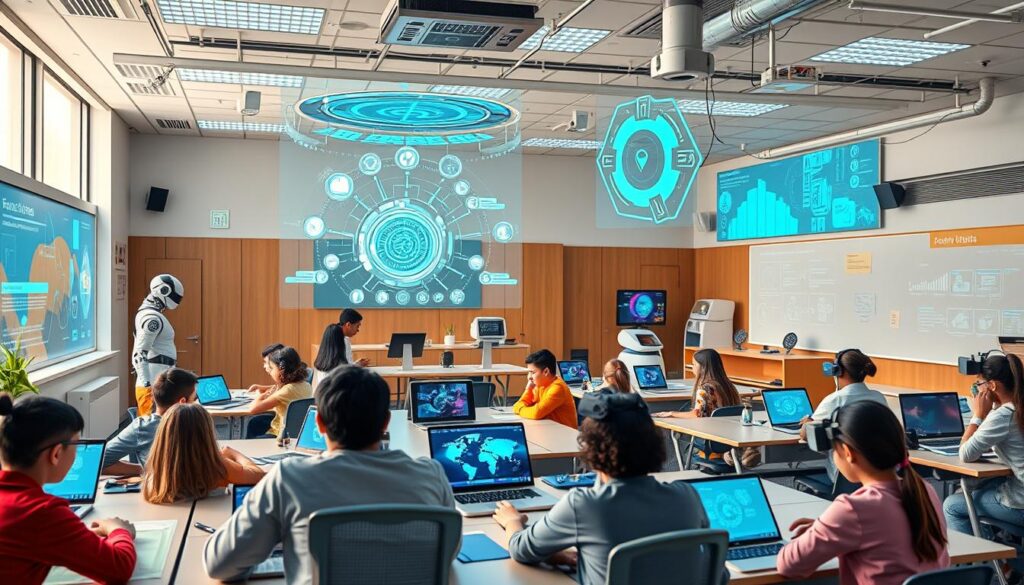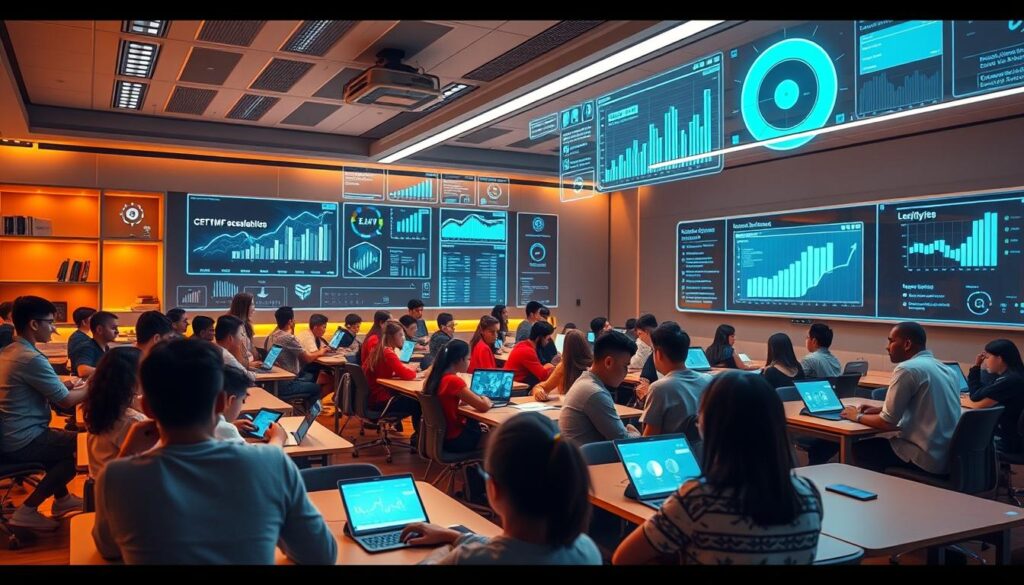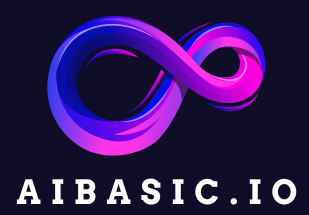AI Tools for Education: Transforming Learning
More than 60% of U.S. teachers now use AI tools to improve learning1. Education is changing fast, thanks to Artificial Intelligence (AI). AI is making learning more personal, flexible, and based on data.
AI tools are changing education in big ways. They can grade work quickly and give detailed info on subjects1. They also help teachers by doing tasks like shortening long videos1. This lets teachers focus more on teaching and helping students grow.

AI has a huge role to play in education. Tools like QuillBot, Quizlet, and Wolfram|Alpha offer many features for students and teachers1. They help with grammar, making learning fun, and more. These tools are making education better, more fun, and more effective.
Key Takeaways
- AI tools are changing education, making learning personal and easier for teachers.
- Over 60% of U.S. educators use AI tools to improve teaching and learning1.
- AI platforms offer many features, from quick grading to interactive learning.
- AI is shaping the future of education, helping students and teachers reach their goals.
- The use of AI in education is a growing, multi-billion dollar market2.
Introduction to AI in Education
AI tools for education use artificial intelligence to make learning better3. They help personalize lessons, automate tasks, and give feedback instantly. Examples include adaptive learning platforms and virtual reality experiences4.
What are AI Tools for Education?
AI tools in education aim to make learning more personal4. They analyze what each student needs and tailor lessons accordingly. These tools offer help and learning paths for all kinds of learners4.
Benefits of AI Tools in the Classroom
AI tools bring many benefits to students and teachers3. They help students learn at their own pace and achieve more. AI also makes learning fun and interactive, keeping students engaged3.
AI can also do tasks like grading, saving teachers time3. This lets teachers focus on teaching and helping students more3.
| AI Tools for Education | Description |
|---|---|
| Adaptive Learning Platforms | Personalize content and pacing based on individual student needs and progress. |
| Intelligent Tutoring Systems | Provide real-time feedback, guidance, and customized learning paths for students. |
| AI-Powered Assessment and Grading | Automate the grading process and provide detailed, immediate feedback to students. |
| Virtual and Augmented Reality | Create immersive, interactive learning experiences to engage students and enhance understanding. |
“AI tools have the potential to revolutionize education by personalizing learning, streamlining administrative tasks, and fostering more engaging and effective classroom experiences.”
But, there are worries about AI’s accuracy, fairness, and privacy in schools4. Teachers need to check if AI tools are reliable and fair before using them435.
Personalized Learning with AI
The future of education is changing thanks to artificial intelligence (AI). Adaptive learning platforms and intelligent tutoring systems are making learning more personal and tailored. This was once thought impossible6.
Adaptive Learning Platforms
Adaptive learning platforms use AI to adjust lessons based on how well each student is doing. They analyze data to find out what each student knows and what they need to work on. This way, they offer lessons and exercises that fit each student’s needs6.
These platforms make learning more effective. They help students understand and remember what they learn better. This leads to better grades and a stronger education6.
Intelligent Tutoring Systems
Intelligent Tutoring Systems (ITS) are AI tools that give one-on-one help to students. They use AI to check what students know, find mistakes, and give feedback. This helps students learn and do better in their studies6.
ITS make learning feel like having a personal tutor. They adjust the difficulty of lessons, offer hints, and provide practice exercises. This helps students grasp new ideas and improve their skills6.
AI makes learning more personal by saving time on making individual plans for students7. AI chatbots give students help with 91% accuracy6. AI also helps predict student outcomes more accurately6.
The AI in education market is growing fast, with a 36.0% CAGR from 2022 to 20236. Companies like Knewton and DreamBox are using AI to create personalized learning experiences6.
AI in learning has many benefits, but we must also think about ethics. We need to protect student data and make sure AI is fair and inclusive. These are important steps as AI in education keeps growing6.
AI-Powered Assessment and Feedback
AI tools are changing how we give feedback and grades in schools. Automated grading uses smart algorithms to score work, making sure it’s fair and consistent8. These tools also check for plagiarism and give detailed feedback, saving teachers time. This lets them focus on helping students more.
AI does more than just grade work9. It helps students by tracking their progress and understanding their needs. It gives feedback and content that’s just right for them. This makes learning more fun and helps students remember what they learn better.
Automated Grading and Evaluation
AI tools are making grading fair and consistent8910. They can quickly grade many types of work, from simple tests to complex essays. This means students get feedback right away. Teachers then have more time to help students learn in a more meaningful way.
Tools like Coursebox, Examsoft, and Classpoint are changing how teachers grade8. They use smart algorithms to give feedback that’s just for each student. This helps students see what they’re good at and where they need to improve. Teachers can then focus on helping students learn deeper, not just grading.
“AI-powered assessment tools have the potential to transform the way we approach evaluation in education, making it more personalized, engaging, and effective for both students and teachers.”
As AI gets better, grading and feedback will keep getting better too8910. This will make learning more fun and effective for everyone in schools.
ai tools for education
Educators today face a big challenge: making exams that are both thorough and fun. This task is time-consuming but can be made easier with AI question paper generators11. These tools use smart algorithms to create different types of questions. They are made to fit specific learning goals and the needs of students11.
By using AI, teachers can save a lot of time. They also make sure exams are fair and consistent for everyone11.
AI Question Paper Generators
AI question paper generators look at the subject matter and curriculum to make a variety of questions11. They adjust the difficulty and style of questions to meet the needs of different students11. This makes creating exams more efficient and effective11.
Teachers can use these AI tools to make their assessment work easier. This lets them focus more on helping students learn and grow.
Generative AI Assessments
Generative AI assessments are a new way to check how well students can think and solve problems12. These systems use smart technology to create interactive, scenario-based tests. They change based on how students answer12.
These assessments use real-world scenarios and questions to test critical thinking and problem-solving skills12. They give educators and students valuable insights. This helps with personalized learning and skill development.
AI has been used in teaching for a while, even before ChatGPT became popular13. AI tools can make teaching more creative and efficient. They help with tasks that take a lot of time and give insights into how students learn13.
Teachers can use many AI tools, like AudioPen, Canva Magic Write, Curipod, Eduaide.Ai, OpenAI, Quizizz, and Slidesgo, to improve their work13. These tools help with brainstorming, writing lesson plans, and making presentations. They make learning more engaging and personalized13.
“AI-powered assessments are revolutionizing the way we evaluate student learning. By creating interactive, adaptive experiences, we can gain deeper insights into our students’ critical thinking and problem-solving skills.” – Dr. Emily Wilder, Director of Educational Technology, University of California, Berkeley
As AI keeps getting better, teachers can find more tools to improve their teaching. They can make assessments easier and provide personalized learning experiences. This helps students reach their full potential131112.
AI for Collaborative Learning
AI tools are changing how students work together and learn14. They help teams by looking at how they work, finding ways to get better, and suggesting how to improve15. Skills like teamwork, talking well, and being flexible are key in AI learning15.
AI lets students find others who share their interests or needs14. This way, they can share ideas, give feedback, and learn from each other14. It makes learning more fun and effective by letting students talk and share easily15. It also helps them see different views, get quick feedback, learn important skills, and fill in knowledge gaps15.
But, using AI in learning also has its downsides15. There are worries about ethics, relying too much on AI, and keeping data safe15. It’s important to find a good balance between humans and AI in learning15.
As AI gets better, it will play a bigger part in how we learn together14. AI will help by giving insights, making content, and helping students talk to each other15. The future of learning with AI is about working well together to get ready for a world with more AI15.
Virtual and Augmented Reality in Education
Virtual reality (VR) and augmented reality (AR) are changing education. They offer immersive learning experiences. Students can interact with digital simulations and visualize complex concepts16.
AI-powered VR and AR tools create interactive environments. They meet different learning styles and preferences16. These technologies improve student engagement and retention of information. They also help develop critical thinking and problem-solving skills.
Immersive Learning Experiences
VR technology has made great strides, with a market size expected to hit $48.5 billion by 202516. VR devices are becoming more affordable for schools16. It helps bridge the gap in distance learning, offering a sense of presence and enhancing engagement16.
Medical students can practice surgeries in VR, improving their skills16. Language students can practice with AI-powered characters, getting feedback to improve their skills16.
AR enhances student engagement by adding artificial objects to real-world environments16. It’s used in STEM and humanities, including engineering and history16. AR is used in blended learning models, making campus visits more immersive16.
AI is transforming education with tools like computer vision and speech recognition17. It personalizes learning by analyzing student data and adapting content17. VR offers immersive experiences, allowing students to explore complex concepts interactively17.
However, there are challenges like high costs and privacy concerns17. Schools can address these by using secure platforms and educating students and parents about data privacy17. Ensuring accessibility and equity is crucial, requiring policies that make technology inclusive17.
Emerging technologies like AR, VR, and AI are changing classrooms into interactive spaces18. AI-powered tutors offer personalized support, making education more inclusive18. But, budget considerations and accessibility are key when integrating these technologies18.

“AI and VR technology can enhance the learning experience by providing tailored content, delivery methods, and immersive hands-on experiences for students.”
AI Tools for Inclusive Education
AI is changing education in big ways. It helps students with different needs, making schools more welcoming for everyone19. AI creates learning materials that are fun and effective for students19. It also makes classrooms more inclusive by using the Universal Design for Learning (UDL) framework19.
UDL focuses on different ways to engage, represent, and express ideas. This helps all kinds of learners.
Supporting Students with Special Needs
AI tools like text-to-speech and facial recognition help students with disabilities19. These tools make learning easier and more fun for them19. AI also helps teachers create lessons that fit each student’s needs19.
AI makes learning materials that fit different learning styles19. This way, every student can learn in their own way.
20 Six tools help diverse learners in class20. Ten ideas make learning fun by using student interests20. In just ten seconds, AI can suggest visual teaching strategies20.
AI can also create different learning plans for students20. It helps with social skills and explains concepts in a way that’s easy to understand20. There’s even a tool to break down tasks into simple steps for everyday use.
19 AI gives feedback in real-time to help students19. It creates learning materials that fit each student’s needs19. AI aims to give everyone a fair chance to learn, no matter their background19.
By using AI and UDL, schools can be more inclusive19. This helps meet the needs of every student.
19 Middle school students benefit from UDL and AI19. AI tools like graphic organizers make learning personal19. AI chatbots offer help and make learning fun and interactive.
19 AI helps prepare students for a diverse workplace19. UDL in AI education prepares students for an inclusive workforce19. It’s important to make AI jobs welcoming to everyone19.
Programs that focus on diversity in STEM are key19. They help address unfairness and encourage more people to join AI careers.
AI-Driven Learning Analytics
In today’s education world, AI learning analytics are changing how teachers help students learn. AI tools collect and analyze lots of data on how students do. This gives teachers key insights to improve their teaching methods21.
AI analytics can check how each student is doing, find out what they’re good at and what they need to work on. They can even guess if a student might struggle with something21. With this info, teachers can plan better lessons, use resources wisely, and help students who need it most21.
Leveraging AI for Personalized Learning
AI learning analytics do more than just track how students do. They help make learning fit each student’s needs, changing what they learn and how they learn it22. This way, teachers can really make a difference in how well students do.
But, using AI in schools also brings up big questions, like keeping student data safe and not relying too much on data21. Teachers should keep up with new AI tools and talk with each other about the good and bad of using them.
“AI-driven learning analytics have the power to revolutionize education, but it’s crucial that we approach their implementation with care and diligence to ensure they truly benefit students and empower teachers.”
As AI gets better, it could really change education for the better. By using AI to understand students better, teachers can make learning more effective. This could make education even better for everyone.

Challenges and Ethical Considerations
AI in education is promising but comes with big challenges. We need to make sure everyone has equal access and that AI is used ethically23. The digital divide is a big issue, where some students lack technology and internet24. This makes it hard for them to keep up with AI tools in school.
To fix this, we need to create AI that works even with slow internet. We also need offline learning options. This way, all students can use these tools, no matter where they are from.
AI tools also collect a lot of student data, which raises privacy and security concerns24. Schools and teachers must protect this data25. We also need to make sure AI is fair, open, and accountable. This will help keep trust and make sure AI helps all students.
Addressing the Digital Divide
- Develop low-bandwidth AI applications to improve accessibility in areas with limited connectivity24
- Provide offline learning options to ensure equitable access to AI-powered tools24
- Implement strategies to bridge the digital divide and ensure all students can benefit from AI-driven education24
Privacy and Data Security
Keeping student data safe is very important as AI tools collect a lot of it.2425 Schools must also be open about how they use AI. This includes being fair and accountable. This way, we can trust AI and use it for the good of all students.
“The adaptation of AI in education must be carefully considered to ensure that these technologies are used in a manner that benefits all students, regardless of their socioeconomic background or access to technology.”
| Key Ethical Considerations | Potential Challenges |
|---|---|
| Data privacy and security | AI systems collecting and analyzing large amounts of student data24 |
| Bias and transparency | AI tools prone to perpetuating existing biases and inequalities24 |
| Equity and accessibility | Digital divide leading to unequal access to AI-powered education tools24 |
| Ethical use of AI | Lack of regulation and policies to address AI implementation issues24 |
By tackling these challenges and using AI ethically in schools, we can make a big difference. We can make sure AI helps all students, no matter their background or access to technology232524.
Emerging Trends in AI for Education
The future of AI in education is full of exciting changes. Educators and learners are seeing new technologies that change how we learn26.
Generative AI tools are becoming more common. They use advanced tech to make learning materials that fit each student’s needs26. These tools help with personalized learning, making content, language learning, and virtual tutoring26.
AI is also being used with other new tech like Augmented Reality (AR) and educational games. This makes learning more fun and tailored to each student’s level27.
But, there are challenges like making sure AI is fair and unbiased26. Open-source tools like TeachAI are helping to make AI in education fair and responsible28.
The future of AI in education looks bright. It will bring more personalization, automation, and fun to learning27. With better AI literacy and ethics, education will keep getting better28.
| Emerging AI Trends in Education | Key Characteristics |
|---|---|
| Generative AI Tools | Powered by advanced machine learning frameworks like transformers Used for personalized learning, automated content creation, language learning, and virtual tutoring Require extensive datasets and high computational resources |
| AI Integration with Emerging Technologies | Incorporation of Augmented Reality (AR) for immersive learning experiences Development of adaptive educational games Potential for enhanced interactivity and personalization |
| Responsible AI Implementation | Addressing ethical considerations and potential biases in AI systems Promoting the use of open-source tools and frameworks for equitable AI integration Emphasis on AI literacy and ethical reasoning in education |
As AI in education grows, it will change how we learn and teach. By using AI wisely and solving its challenges, we can make education better for everyone262827.
Conclusion
AI in education could change how we learn, helping students and teachers do better29. AI tools offer personalized lessons, handle boring tasks, and give instant feedback. This makes learning more effective30. But, we must make sure everyone has access to these tools, no matter their background31.
AI has shown it can improve education in many ways. It helps students think critically and work better together29. AI also helps students learn at their own pace, making learning more personal30.
To make AI work for everyone, we need to work together31. We must tackle issues like unequal access and teach people about AI. This way, AI can help make learning better for everyone31. With teamwork, AI can help shape the future of education and prepare the next generation30.
FAQ
What are AI tools for education?
AI tools for education use artificial intelligence to improve learning. They make lessons more personal, automate tasks, and offer feedback in real-time. They also create engaging learning environments.
What are the benefits of using AI tools in the classroom?
AI tools help students and teachers a lot. They make learning personal, engaging, and interactive. They also help teachers focus on teaching by doing tasks like grading.
How do adaptive learning platforms work?
Adaptive learning platforms adjust to how each student learns. They use AI to understand what each student knows and needs. This way, they offer lessons that fit each student’s learning style.
What are Intelligent Tutoring Systems (ITS)?
ITS are AI tools that give one-on-one help to students. They use AI to understand what students know and help them learn more. They make learning more effective and fun.
How do AI-powered assessment and feedback tools work?
These tools make grading and feedback easier and more accurate. They use AI to score assignments and give detailed feedback. This helps teachers save time and focus on helping students more.
What are AI Question Paper Generators?
These tools help create exam questions easily. They use AI to make a variety of questions based on the curriculum. This makes creating exams faster and fairer.
What are Generative AI Assessments?
These assessments use AI to test students in a new way. They ask questions based on the student’s answers, making the test more interactive. This helps assess skills like problem-solving and communication.
How can AI support collaborative learning?
AI tools help groups work better together. They analyze how well team members work together and suggest ways to improve. They also help students share ideas and learn from each other.
How can AI enhance immersive learning experiences?
AI makes learning more real with VR and AR. These tools let students explore and learn in a hands-on way. They make learning more fun and effective.
How can AI support students with special educational needs?
AI helps students with special needs by making learning more accessible. It offers tools like text-to-speech and adaptive learning. This ensures all students get the help they need.
How can AI-driven learning analytics benefit educators?
AI analytics give teachers valuable insights on how students are doing. They help teachers see what works and what doesn’t. This helps improve teaching and learning for everyone.
What are the challenges and ethical considerations in implementing AI in education?
Using AI in education is promising but comes with challenges. There’s a need to ensure everyone has access to technology. There are also concerns about privacy and fairness. It’s important to use AI in a way that benefits all students.
MUST READ :https://aibasic.io/the-future-of-robots-whats-next-in-automation/
Source Links
- Top 12+ AI Tools for Education – https://www.geeksforgeeks.org/ai-tools-for-education/
- 10 Best AI Tools for Education (September 2024) – https://www.unite.ai/10-best-ai-tools-for-education/
- Artificial Intelligence In Education: Teachers’ Opinions On AI In The Classroom – https://www.forbes.com/advisor/education/it-and-tech/artificial-intelligence-in-school/
- Research Guides: AI Tools for Education : Home – https://guides.libraries.uc.edu/ai-education
- Introduction to Artificial Intelligence (AI) and Education – University of San Diego – Professional & Continuing Education – https://pce.sandiego.edu/courses/introduction-to-artificial-intelligence-ai-and-education/
- The Role of AI in Personalized Learning – https://claned.com/the-role-of-ai-in-personalized-learning/
- Perspective | An educator’s journey through personalized learning to AI integration – https://www.ednc.org/educators-journey-personalized-learning-artificial-intelligence-ai-integration/
- Top 10 AI Assessment Tools For Educational Institutes | Coursebox AI – https://www.coursebox.ai/blog/best-ai-assessment-tools
- 6 Practical Approaches of AI for Learning Assessments to Boost Student Success (2024) – https://www.disco.co/blog/ai-for-learning-assessments
- AI for Educators Series: Part Five: Utilizing AI for Assessment and Feedback – https://www.linkedin.com/pulse/ai-educators-series-part-five-utilizing-assessment-feedback-scott-ahbnc
- MagicSchool – AI Built for Schools – https://www.magicschool.ai/
- Brisk Teaching – Free AI for Teachers – https://www.briskteaching.com/
- 7 AI Tools That Help Teachers Work More Efficiently – https://www.edutopia.org/article/7-ai-tools-that-help-teachers-work-more-efficiently/
- AI And Education: A Collaborative Approach – https://elearningindustry.com/ai-and-education-a-collaborative-approach
- AI-Enhanced Collaborative Learning – https://hyperspace.mv/collaborative-learning-ai/
- VR, AR and AI will Transform Universities. Here’s How. | UNBOUND – https://unbound.upcea.edu/online-2/online-education/vr-ar-and-ai-will-transform-universities-heres-how/
- Evolving Education: The Impact Of AI And VR Technology On The Future Of Learning – https://elearningindustry.com/evolving-education-the-impact-of-ai-and-vr-technology-on-the-future-of-learning
- STEAM Connect #007 The Future of Work: Exploring the Exciting World of STEAM Careers – https://digitalmediaacademy.org/future-of-learning-vr-ar-classroom/
- Gen AI, Inclusive Education and UDL: Transforming Learning for All – https://medium.com/@niall.mcnulty/gen-ai-inclusive-education-and-udl-transforming-learning-for-all-a8705e5ad576
- AI Tools for Inclusive Schools (The Universal Sandpit) – https://education.apple.com/resource/250011982
- AI-Powered Learning Analytics Are Shaping Early Childhood Education and Instruction – Childhood Education International – https://ceinternational1892.org/article/how-ai-powered-learning-analytics-are-shaping-early-childhood-education-and-instruction/
- AI-Driven Evolution in Learning Analytics for Digital Education – https://www.digitallearninginstitute.com/blog/ai-driven-evolution-in-learning-analytics-for-digital-education
- Artificial intelligence in education: Addressing ethical challenges in K-12 settings – https://www.ncbi.nlm.nih.gov/pmc/articles/PMC8455229/
- Research Guides: Artificial Intelligence (AI) in Education: AI and ethics – https://guides.lib.jmu.edu/AI-in-education/ethics
- Ethical AI for Teaching and Learning – https://teaching.cornell.edu/generative-artificial-intelligence/ethical-ai-teaching-and-learning
- Generative AI In Education: Key Tools And Trends For 2024-2025 – https://elearningindustry.com/generative-ai-in-education-key-tools-and-trends-for-2024-2025
- Five AI Trends In Education Shaping the Future of Education – https://www.panopto.com/blog/five-ai-trends-that-are-good-news-for-higher-education/
- 7 Artificial Intelligence Trends That Could Reshape Education in 2024 – https://www.the74million.org/article/7-artificial-intelligence-trends-that-could-reshape-education-in-2024/
- Guiding Students to Assess the Merits of Artificial Intelligence Tools – https://www.edutopia.org/article/teaching-students-use-ai-tools/
- AI in the Classroom | Greylock – https://greylock.com/greymatter/ai-in-the-classroom/
- AI in Education: Expert Discussions on Shaping the Future of Learning – https://www.linkedin.com/pulse/ai-education-expert-discussions-shaping-future-learning-cobo-ac6ue


One Comment on “AI Tools for Education: Transforming Learning”